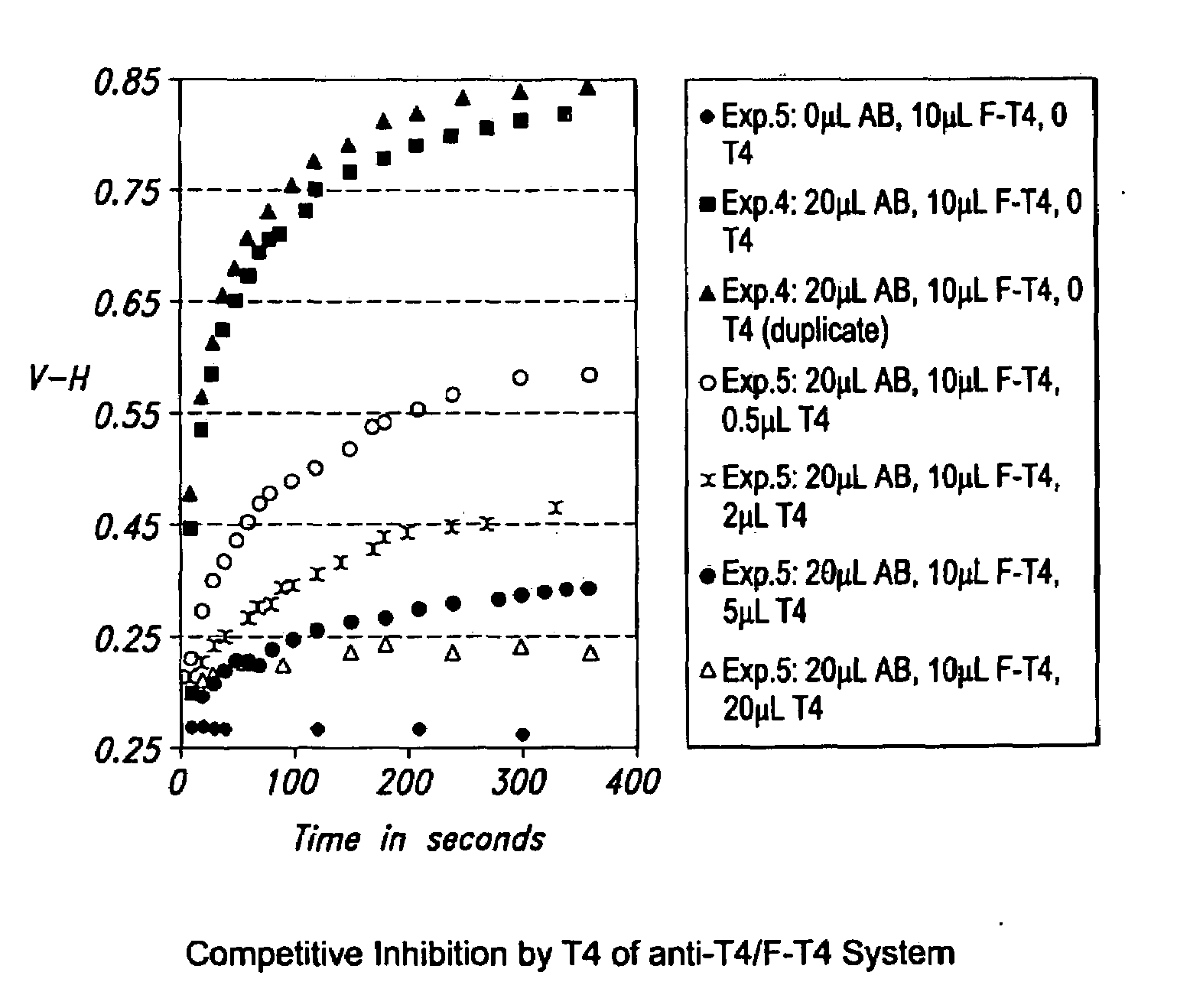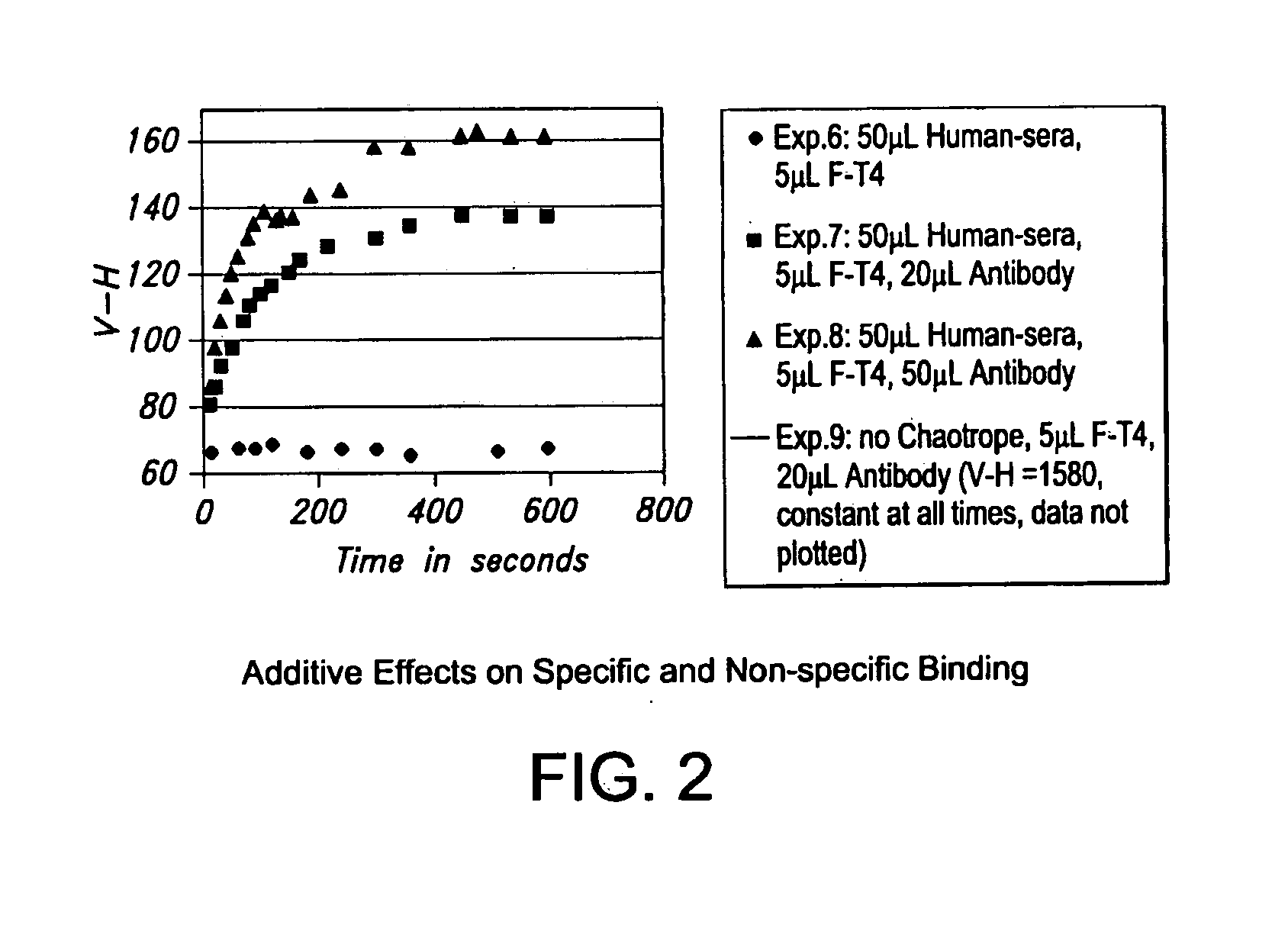Use of additives to lower the rate of a binding reaction
a technology of binding reaction and additives, which is applied in the field of additives to lower the rate of binding reaction, can solve the problems of low detection efficiency, low detection efficiency, and loss of sensitivity, so as to improve the detection assay, reduce the rate of competitive reaction, and reduce the loss of background signals
- Summary
- Abstract
- Description
- Claims
- Application Information
AI Technical Summary
Benefits of technology
Problems solved by technology
Method used
Image
Examples
example 1
Materials
Preparation of Buffers
[0100]The influence of at least one additive on a reaction occurring between specific binding molecules was investigated in pH 7.5 buffer solutions. These buffer solutions were denoted “Buffer 1” and “Buffer 2” and each contained a different amount of sodium benzoate.
Buffer 1:
[0101]0.5 M sodium benzoate in Phosphate Buffered Saline (PBS), adjusted to pH 7.5. The final concentration of sodium benzoate in buffer 1 was about 7.2% w / v.
Buffer 2:
[0102]1.0 M sodium benzoate in PBS, adjusted to pH 7.5. The final concentration of sodium benzoate in buffer 2 was about 14.4% w / v.
Preparation of Anti-Sera Stock Solution
[0103]An initial stock solution of anti-thyroxine sera was prepared. In particular, 1 ml of polyclonal anti-thyroxine sera containing 10 mg / ml IgG (Sigma) was diluted 1:5 in PBS buffer, pH 7.5. The final concentration of IgG in the stock solution was about 2 mg / ml.
Preparation of Thyroxine Stock Solution
[0104]An initial stock solution of an analyte (t...
example 2
Kinetic Curve Measurement Methodology
[0106]The following is a protocol useful for performing a fluorescein polarization assay of the present invention. All steps are performed at ambient temperature. The total final reaction volume after all additions is 3030 μl.[0107]1. Add 20 μl or 0 μl (control) anti-sera stock solution to about 2980 μl of Buffer 1.[0108]2. Pipette the diluted anti-sera solution prepared in step 1 up and down from 1 to 10 seconds to thoroughly mix.[0109]3. Add between 0 and 20 μl thyroxine stock solution (e.g., 0, 0.5, 2.0, 5.0 and 20 μl) to the mixed anti-sera from step 2.[0110]4. Pipette the mixture formed in step 3 up and down for 1 to 10 seconds and then incubate for 30 to 300 seconds.[0111]5. Add 10 μl of the Fluorescein-labeled thyroxine stock solution to the incubated mixture from step 4.[0112]6. Pipette the mixture formed in step 5 up and down for 1 to 10 seconds and begin measuring polarization (P), Polarized Fluorescence Intensity Difference (V−H) or qu...
example 3
Kinetic Curve Measurable in the Presence of an Additive Using a Fluorescein-Labeled Thyroxine / Anti-Thyroxine System
[0115]This example demonstrates that a reaction between F-thyroxine and its specific antibody was only capable of being followed when the reaction was performed in the presence of an additive. The additive in the present example was sodium benzoate. The thyroxine / anti-thyroxine system is well known to be a very difficult system to measure due to thyroxine's capacity to bind to many things non-specifically. It was for this reason that the thyroxine-anti-thyroxine system was chosen as a model system to demonstrate the present invention.
[0116]The materials described in Example 1 and the protocol described in Example 2 were used for each of Experiments 1 to 5 shown in Table 1 below, except that for Experiments 1 to 3, the reaction was performed in PBS instead of Buffer 1. Experiment No. 1 is a control to establish baseline measurements for polarization (P), V−H, and V+H.
TAB...
PUM
| Property | Measurement | Unit |
|---|---|---|
| time-constant | aaaaa | aaaaa |
| time-constant | aaaaa | aaaaa |
| fluorescent | aaaaa | aaaaa |
Abstract
Description
Claims
Application Information
 Login to View More
Login to View More - R&D
- Intellectual Property
- Life Sciences
- Materials
- Tech Scout
- Unparalleled Data Quality
- Higher Quality Content
- 60% Fewer Hallucinations
Browse by: Latest US Patents, China's latest patents, Technical Efficacy Thesaurus, Application Domain, Technology Topic, Popular Technical Reports.
© 2025 PatSnap. All rights reserved.Legal|Privacy policy|Modern Slavery Act Transparency Statement|Sitemap|About US| Contact US: help@patsnap.com



